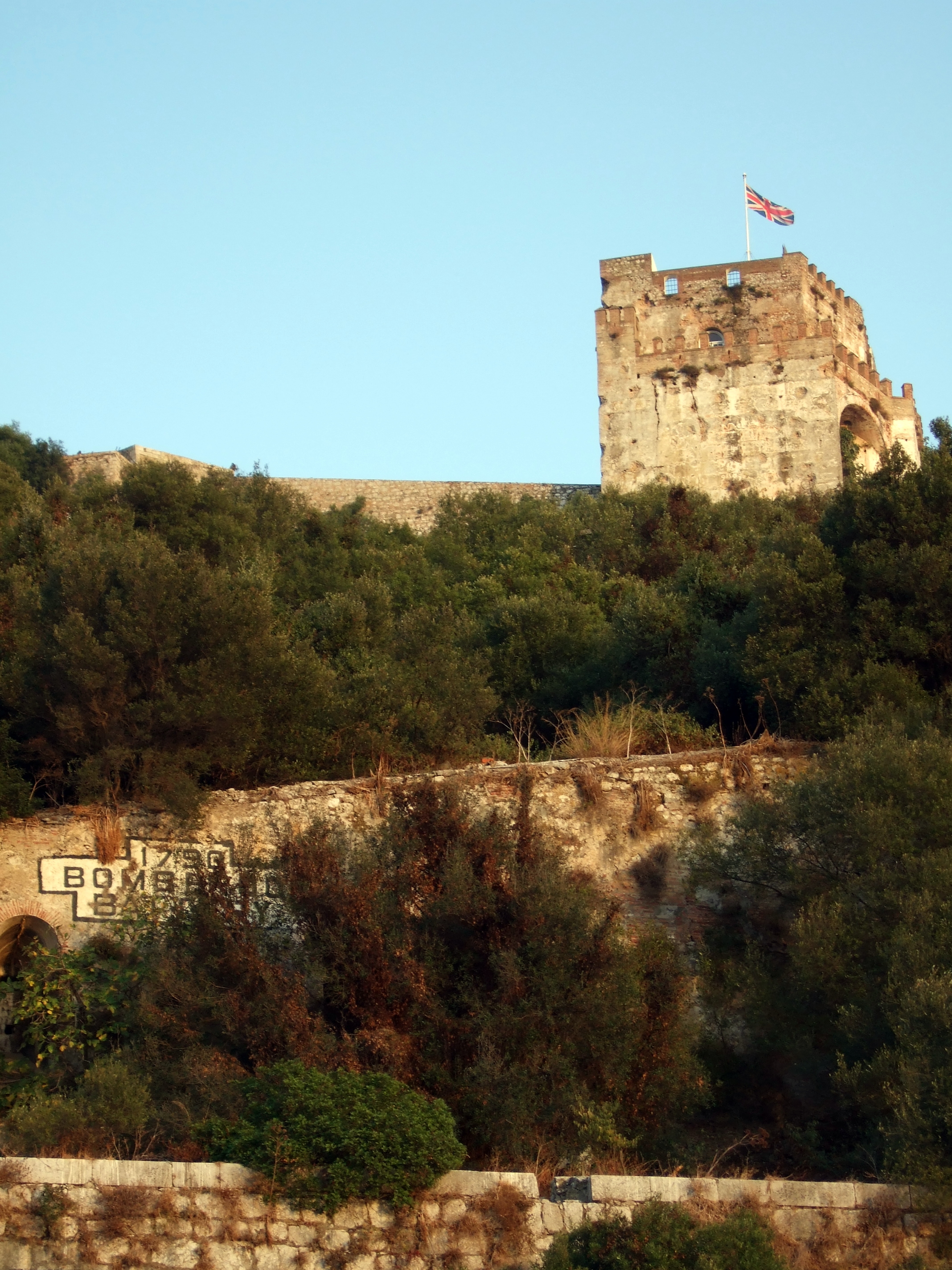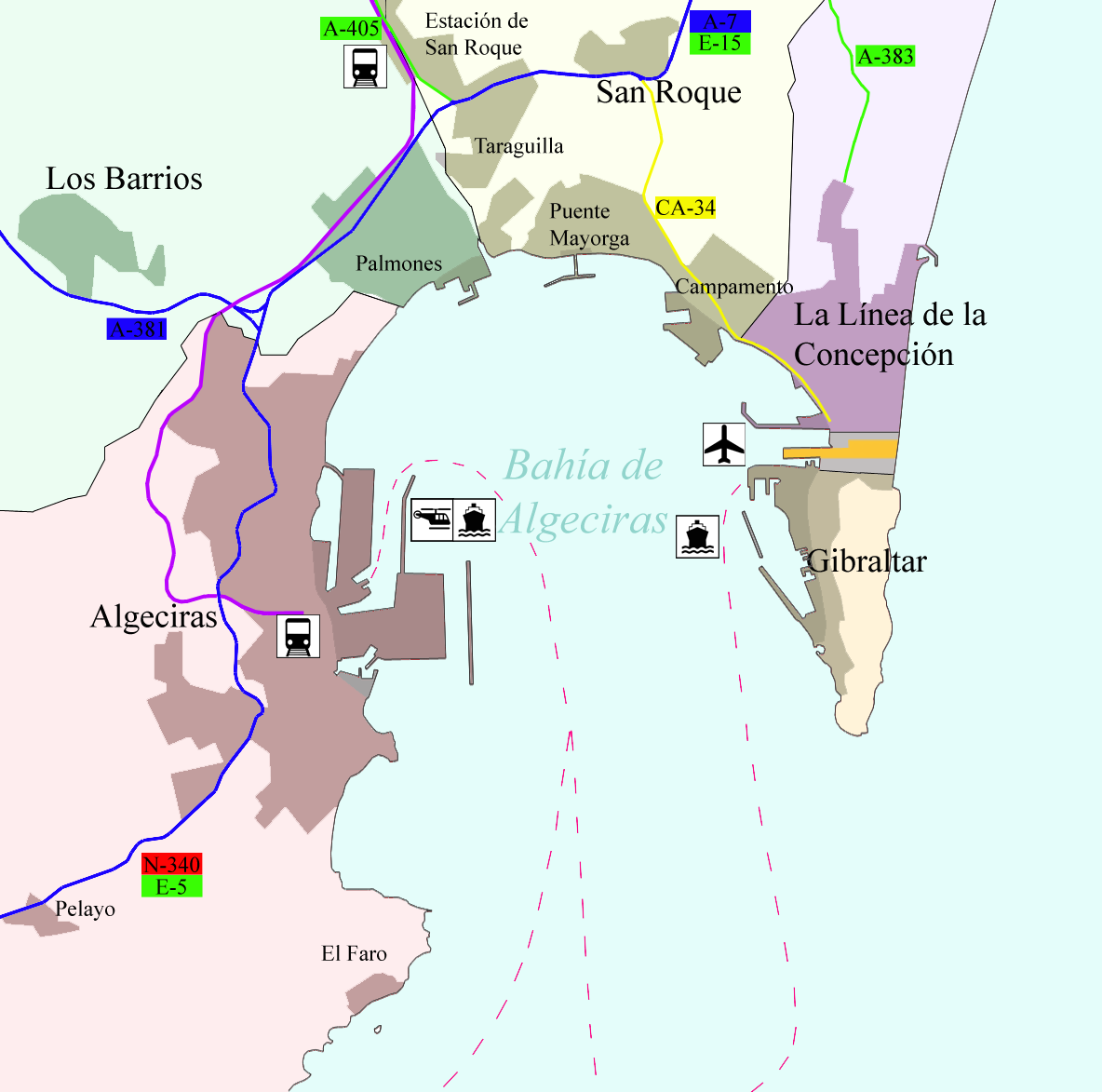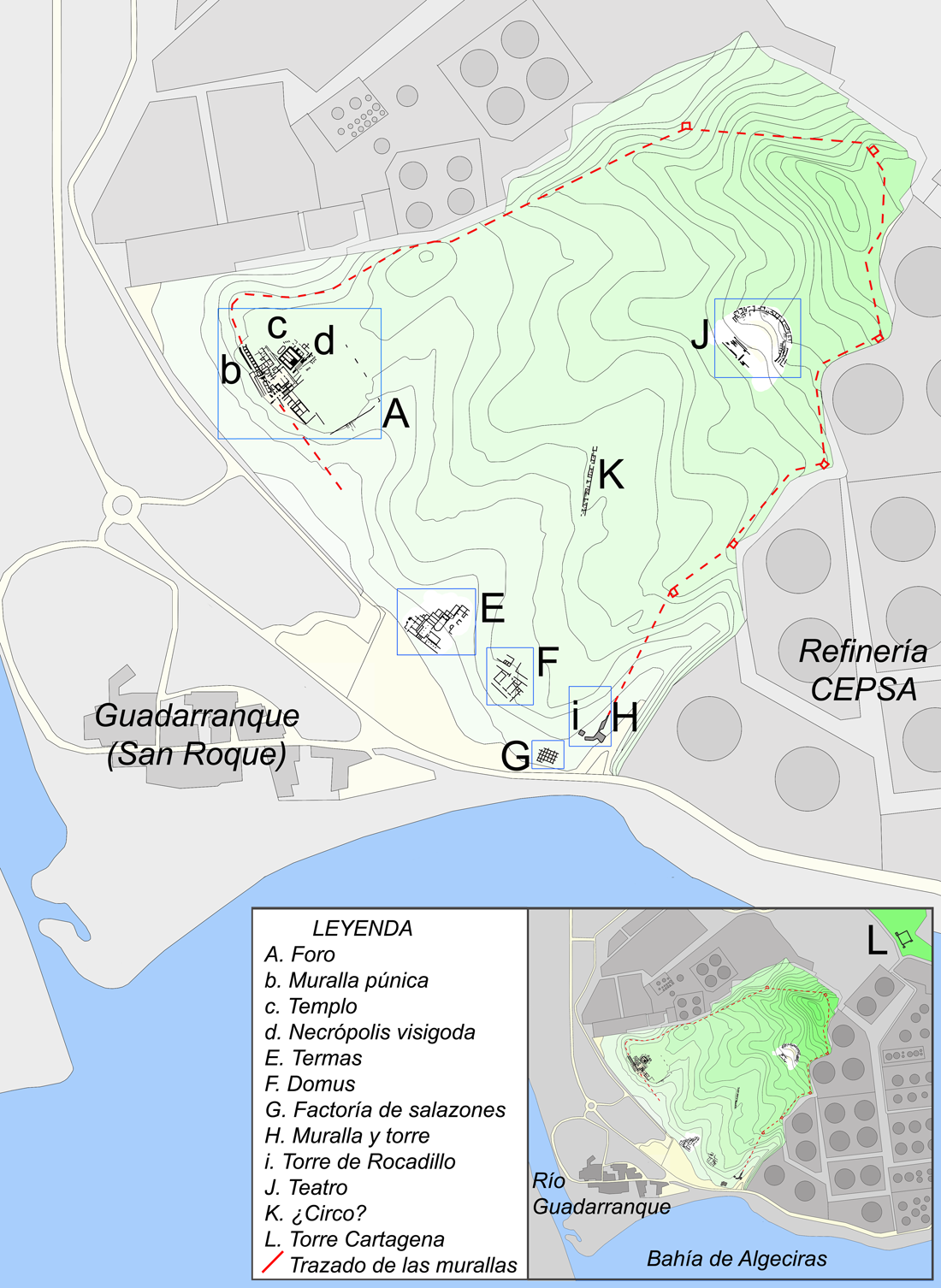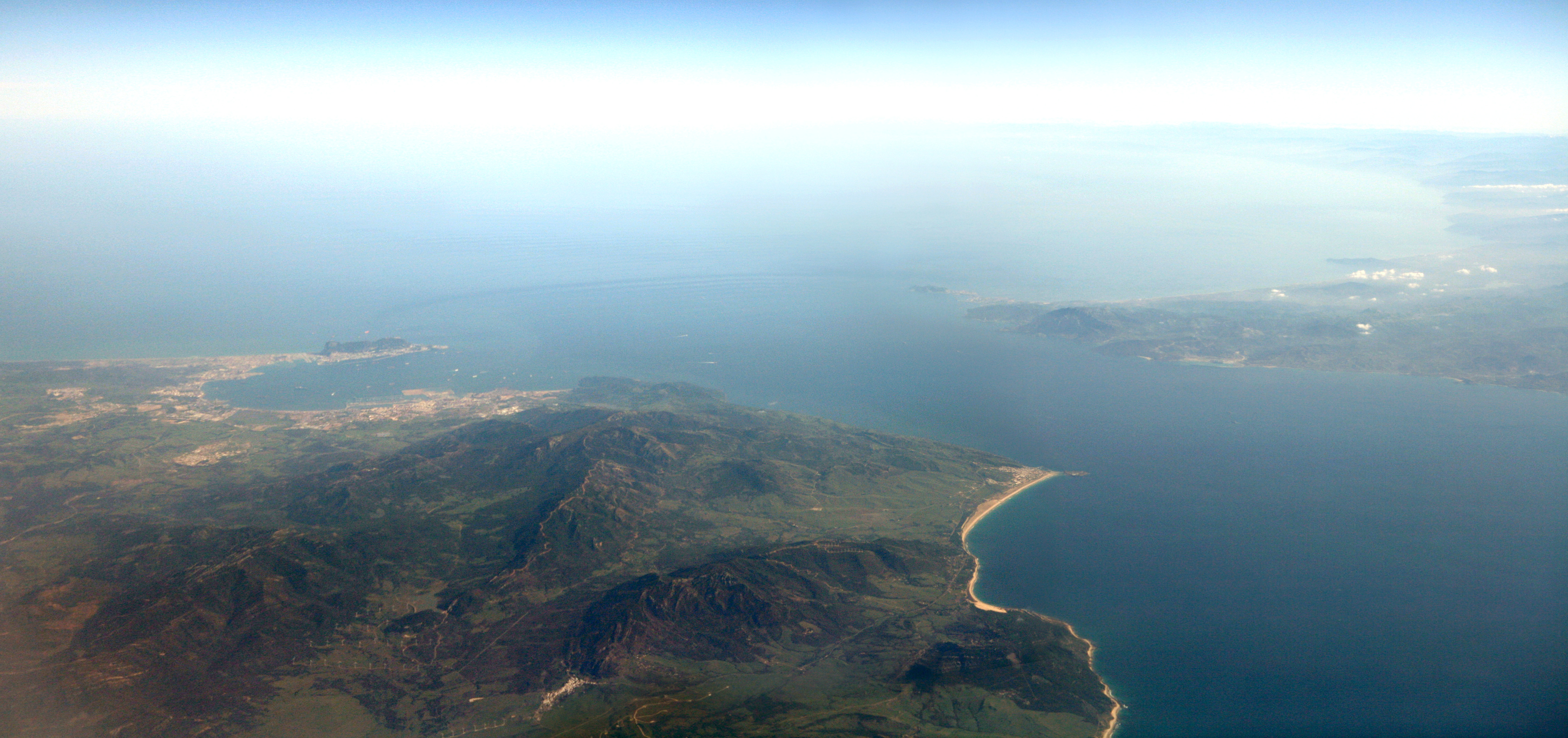|
Moorish Gibraltar
The history of Moorish Gibraltar began with the landing of the Muslims in Hispania and the fall of the Visigothic Kingdom of Toledo in 711 and ended with the fall of Gibraltar to Christian hands 751 years later, in 1462, with an interregnum during the early 14th century. The Muslim presence in Gibraltar began on 27 April 711 when the Berber general Tariq ibn-Ziyad led the initial incursion into Iberia in advance of the main Moorish force under the command of Musa ibn Nusayr, Umayyad governor of Ifriqiya. Gibraltar was named after Tariq, who was traditionally said to have landed on the shores of the Rock of Gibraltar, though it seems more likely that he landed somewhere nearby. Muslim sources claimed that Tariq established some kind of fortification on the Rock, but no evidence has been found and it is not considered credible. It was not until 1160 that a first fortified settlement was built there. The ''Madinat al-Fath'' ( en, City of Victory) was intended to be a major city ... [...More Info...] [...Related Items...] OR: [Wikipedia] [Google] [Baidu] |
Moorish Castle
The Moorish Castle is the name given to a medieval fortification in Gibraltar comprising various buildings, gates, and fortified walls, with the dominant features being the Tower of Homage and the Gate House. Part of the castle itself also housed the prison of Gibraltar until it was relocated in 2010. The Tower of Homage is clearly visible to all visitors to Gibraltar; not only because of its striking construction, but also because of its dominant and strategic position. Although sometimes compared to the nearby '' alcazars'' in Spain, the Moorish Castle in Gibraltar was constructed by the Marinid dynasty, making it unique in the Iberian Peninsula. History Gibraltar has always been of special significance to the numerous peoples and civilizations that have visited or occupied it over the ages, from the Neanderthal period, through the Classical and on to Moorish, Spanish, and the current British rule. The Moorish occupation is by far the longest in Gibraltar's recorded histo ... [...More Info...] [...Related Items...] OR: [Wikipedia] [Google] [Baidu] |
Abd Al-Mu'min
Abd al Mu'min (c. 1094–1163) ( ar, عبد المؤمن بن علي or عبد المومن الــكـومي; full name: ʿAbd al-Muʾmin ibn ʿAlī ibn ʿAlwī ibn Yaʿlā al-Kūmī Abū Muḥammad) was a prominent member of the Almohad movement. Although the Almohad movement itself was founded by Ibn Tumart, Abd al-Mu’min was the founder of the Almohad dynasty and creator of the dynasty's empire. As a leader of the Almohad movement he became the first Caliph of the Almohad Empire in 1133, after the death in 1130 of the movement's founder, Ibn Tumart, and ruled until his death in 1163. Abd al-Mu'min put his predecessor's doctrine of Almohadism into practice, defeated the Almoravids in present-day Morocco, and extended his rule across Al-Andalus (on the Iberian Peninsula) and as far as Tunis in Ifriqiya (present-day Tunisia), thus bringing the Maghreb in North Africa and Al-Andalus in Europe under one creed and one government. Early life Abd al-Mu'min was born ... [...More Info...] [...Related Items...] OR: [Wikipedia] [Google] [Baidu] |
Alboran Sea
The Alboran Sea (from Arabic , ''al-Baḥrān'') is the westernmost portion of the Mediterranean Sea, lying between the Iberian Peninsula and the north of Africa (Spain on the north and Morocco and Algeria on the south). The Strait of Gibraltar, which lies at the west end of the Alboran Sea, connects the Mediterranean with the Atlantic Ocean. Geography Its average depth is and maximum depth is . The International Hydrographic Organization defines the limits of the Alboran Sea as follows: ''On the West.'' The Eastern limit of the Strait of Gibraltar: A line joining from tip ( Europa Point) of '' Cap Gibraltar'' in Europe to the tip of the ''Península de Almina'' of Ceuta in Africa (). ''On the East.'' A line joining from ''Cabo de Gata'' in Andalusia in Europe to ''Cap Fegalo'', near Oran, Algeria in Africa (). Several small islands dot the sea, including the eponymous Isla de Alborán. Most, even those close to the African shore, belong to Spain. Geology The Alboran ... [...More Info...] [...Related Items...] OR: [Wikipedia] [Google] [Baidu] |
Bay Of Gibraltar
The Bay of Gibraltar ( es, Bahía de Algeciras), is a bay at the southern end of the Iberian Peninsula. It is around long by wide, covering an area of some , with a depth of up to in the centre of the bay. It opens to the south into the Strait of Gibraltar and the Mediterranean Sea. The shoreline is densely settled. From west to east, the shore is divided between the Spanish municipalities of Algeciras, Los Barrios, San Roque, La Línea de la Concepción and the British Overseas Territory of Gibraltar. The larger part of the shoreline is Spanish territory, with part of the eastern half of the bay belonging to Gibraltar. The east and west entrances to the bay are marked respectively by the Europa Point Lighthouse at Europa Point, Gibraltar and the Punta Carnero Lighthouse in Punta Carnero to the west of Algeciras. History The area around the Bay of Gibraltar has been inhabited for millennia and the bay itself has been used by merchant shipping for at least 3,000 years. Th ... [...More Info...] [...Related Items...] OR: [Wikipedia] [Google] [Baidu] |
Carteia
Carteia ( grc, Καρτηίᾳ) was a Phoenician and Roman town at the head of the Bay of Gibraltar in Spain. It was established at the most northerly point of the bay, next to the town of San Roque, about halfway between the modern cities of Algeciras and Gibraltar, overlooking the sea on elevated ground at the confluence of two rivers, nowadays called Guadarranque and Cachon. According to Strabo, it was founded around 940 BC as the trading settlement of ''Kʿrt'' (meaning "city" in the Phoenician language; compare Carthage and Cartagena). The area had much to offer a trader; the hinterland behind Carteia, in the modern south of Andalusia, was rich in wood, cereals, oranges, lemons, lead, iron, copper and silver. Dyes were another much sought-after commodity, especially those from the murex shellfish, used to make the prized Tyrian purple. Strabo and Pomponius Mela, mention that some believe that Carteia used to be the Tartessos. Pliny the Elder writes that Carteia was call ... [...More Info...] [...Related Items...] OR: [Wikipedia] [Google] [Baidu] |
Colonia (Roman)
A Roman (plural ) was originally a Roman outpost established in conquered territory to secure it. Eventually, however, the term came to denote the highest status of a Roman city. It is also the origin of the modern term ''colony''. Characteristics Under the Roman Republic, which had no standing army, bodies of their own citizens were planted in conquered towns as a kind of garrison. There were two types: * Roman colonies, ''coloniae civium Romanorum'' or ''coloniae maritimae'', as they were often built near the sea, e.g. Ostia (350 BC) and Rimini (268 BC). The colonists consisted of about three hundred Roman families and were given a small plot of land so were probably small business owners. * Latin colonies (''coloniae Latinae'') were considerably larger than Roman colonies. They were military strongholds near or in enemy territory. The colonists were given large estates up to 35 hectares. They lost their citizenship which they could regain if they returned to Rome. A ... [...More Info...] [...Related Items...] OR: [Wikipedia] [Google] [Baidu] |
Strait Of Gibraltar
The Strait of Gibraltar ( ar, مضيق جبل طارق, Maḍīq Jabal Ṭāriq; es, Estrecho de Gibraltar, Archaism, Archaic: Pillars of Hercules), also known as the Straits of Gibraltar, is a narrow strait that connects the Atlantic Ocean to the Mediterranean Sea and separates the Iberian Peninsula in Europe from Morocco in Africa. The two continents are separated by of ocean at the Strait's narrowest point between Punta de Tarifa, Point Marroquí in Spain and Point Cires in Morocco. Ferries cross between the two continents every day in as little as 35 minutes. The Strait's depth ranges between which possibly interacted with the lower mean sea level of the last major glaciation 20,000 years ago when the level of the sea is believed to have been lower by . The strait lies in the territorial waters of Morocco, Spain, and the British overseas territory of Gibraltar. Under the United Nations Convention on the Law of the Sea, foreign vessels and aircraft have the freedom of navi ... [...More Info...] [...Related Items...] OR: [Wikipedia] [Google] [Baidu] |
Roderic
Roderic (also spelled Ruderic, Roderik, Roderich, or Roderick; Spanish and pt, Rodrigo, ar, translit=Ludharīq, لذريق; died 711) was the Visigothic king in Hispania between 710 and 711. He is well-known as "the last king of the Goths". He is actually an extremely obscure figure about whom little can be said with certainty. He was the last Goth to rule from Toledo, but not the last Gothic king, a distinction which belongs to Ardo. Roderic's election as king was disputed and he ruled only a part of Hispania with an opponent, Achila, ruling the rest. He faced a rebellion of the Basques and the Umayyad invasion. He was defeated and killed at the Battle of Guadalete. His widow Egilona is believed to have married Abd al-Aziz ibn Musa, the first Muslim governor of Hispania. Early life According to the late ''Chronicle of Alfonso III'', Roderic was a son of Theodefred, himself a son of king Chindaswinth, and of a woman named Riccilo. Roderic's exact date of birth is unknow ... [...More Info...] [...Related Items...] OR: [Wikipedia] [Google] [Baidu] |
Julian, Count Of Ceuta
Julian, Count of Ceuta ( es, Don Julián, Conde de Ceuta,, ar, يليان, (' , ''Youliān Kont Sabteh''; in Ibn 'Abd al-Hakam, بؙلْيان, ''Bulyan'', the latter is treated by the editor of the Arabic text, Torrey, as a copying error. 'Abd al-Hakam gives him the title صاحب سبتة (', "Lord of Ceuta"). , group="nb") was, according to some sources, a renegade governor, possibly a former ''comes'' in Byzantine service in Ceuta and Tangiers who subsequently submitted to the king of Visigothic Spain before secretly allying with the Muslims. According to Arab chroniclers, Julian had an important role in the Umayyad conquest of Hispania, a key event in the history of Islam, and in the subsequent history of what were to become Spain and Portugal. Historicity As a historical figure, little is known about Count Julian. The earliest extant source describing Julian is Ibn 'Abd al-Hakam's 9th-century ''Kitāb futuḥ misr wa akbārahā'' (''The History of the Conquests of Egyp ... [...More Info...] [...Related Items...] OR: [Wikipedia] [Google] [Baidu] |
Ibn 'Abd Al-Hakam
Abu'l Qāsim ʿAbd ar-Raḥman bin ʿAbdullah bin ʿAbd al-Ḥakam (Arabic: أبو القاسم عبد الرحمن بن عبد الله بن عبد الحكم), generally known simply as Ibn ʿAbd al-Ḥakam (Arabic: ابن عبد الحكم) (801 AD - 257 A.H/ 871 A.D at al-Fustat near Cairo) was an Arab historian born in Fustat, Egypt who wrote a work generally known as " The Conquest of Egypt and North Africa and Spain (Andalusia) " ( ar, فتح مصر و المغرب و الاندلس, ''Futūḥ mișr wa'l maghrab wa'l andalus''). This work is considered one of the earliest Arabic Islamic histories to have survived to the present day. Life Ibn Abd al-Hakam came from an Arab family. The author's father ʿAbdullah and brother Muhammad were the leading Egyptian authorities of their time (early 9th century) on Malikite Islamic law. After the father's death, the family were persecuted by the caliph Al-Wathiq for their adherence to orthodox doctrine. Although much quoted by early ... [...More Info...] [...Related Items...] OR: [Wikipedia] [Google] [Baidu] |
Fuertes
Fuertes is a surname. Notable people with the surname include: * Antonio Fuertes (1929–2015), Spanish footballer *Gloria Fuertes (1917–1998), Spanish poet and author of children's literature *Gustavo Fuertes (born 1959), Spanish screenwriter and director of Spanish cinema * Eduardo Fuertes (born 1943), Filipino footballer *Esteban Fuertes (born 1972), Argentine football striker *Estevan Antonio Fuertes (1838–1903), Puerto Rican-American astronomer and civil engineer * James Hillhouse Fuertes (1863–1932), United States civil and sanitary engineer * José María Mohedano Fuertes (born 1948), Spanish lawyer and politician * Juan Jose Fuertes Martinez (born 1976), Spanish swimmer *Louis Agassiz Fuertes (1874–1927), American ornithologist, illustrator and artist *Jesus Fuertes (1938–2006), Spanish Cubist painter * Maria Fuertes, 2020 American murder victim *Pilar Fuertes Ferragut (1962–2012), Spanish diplomat * Xavier Pascual Fuertes (born 1968), Spanish former handball pla ... [...More Info...] [...Related Items...] OR: [Wikipedia] [Google] [Baidu] |
Juan Alonso De Guzmán, 1st Duke Of Medina Sidonia
Juan Alonso de Guzmán y Suárez de Figueroa Orozco, 1st Duke of Medina Sidonia and 3rd Count de Niebla (in full, es, Don Juan Alonso de Guzmán y Suárez de Figueroa Orozco, primer Duque de Medina Sidonia, tercer Conde de Niebla, Señor de Sanlúcar de Barrameda, Señor de Lepe, Ayamonte y Gibraltar, Adelantado Mayor de la Frontera de Andalucía) (c. 1405 – December 1468) was a Spanish nobleman and military figure of the Reconquista. Juan Alonso de Guzmán was the son of Enrique de Guzmán, 2nd Count of Niebla and of Teresa Suárez de Figueroa y Orozco, Lady of Escamilla and Santa Olalla. He was awarded the title of Duke of Medina Sidonia by King John II of Castile on February 1445. He married Doña Maria de la Cerda y de Sarmiento, daughter of Luis de la Cerda y Mendoza, 3rd Count de Medinaceli. It seems there was no legal male issue. He had however more than one illegitimate child with an Isabel de Menezes y Fonseca, apparently also marrying Doña Elvira de Guzmán, dau ... [...More Info...] [...Related Items...] OR: [Wikipedia] [Google] [Baidu] |






